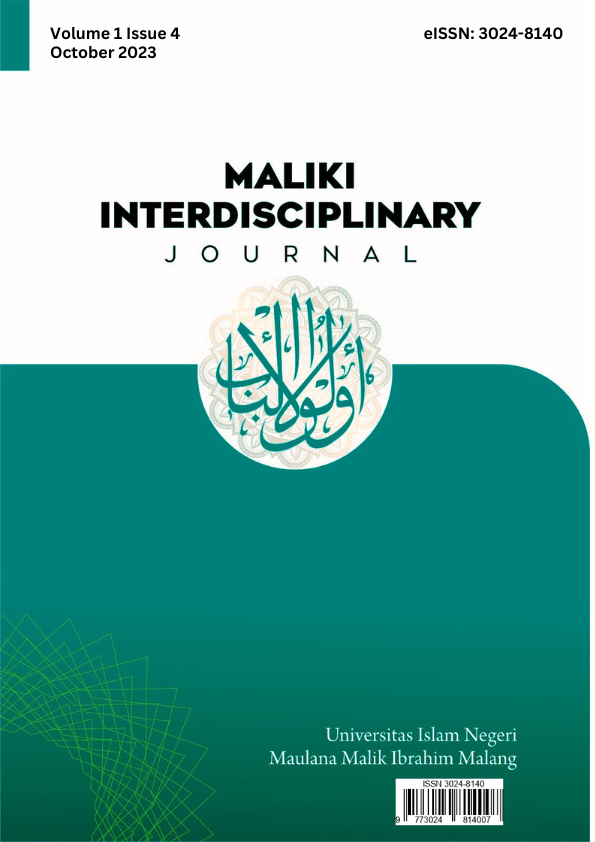Penciptaan dan pembentukan janin manusia dalam pandangan Al-Quran, Hadist dan ilmu sains
Abstract
Humans are perfect creatures and are the best of all God's other creations. The creation of humans can be seen from two elements, namely the essence of the soil and the spirit, so one can see that the creation of humans can be collected into two, namely the creation of the first humans, namely the prophet Adam, Eve and the creation of the children of Adam. The fetus before becoming a baby which is then born goes through several developmental phases that occur in the mother's womb. Allah explains in the Qur'an that the phases of fetal development go through the stages of germ cells, namely sperm cells, then 'Alaqah, which is a clot of blood, mudghoh, which is a lump of flesh, finally izam and lahm, namely the formation of bones that are formed before the formation of muscles. In terms of the scientific process, the occurrence of humans occurs in three phases, namely the zygote phase, this phase begins when experiencing division until the end of the second week. The next phase is the embryo, this phase starts from the second week to the fourth week. Finally, the fetal phase is marked by a bulge, and on the fourth return the fetus is seen to be actively moving and the organs are complete.
Downloads
References
Blott, M. (2013). Ensiklopedia kehamilan hari demi hari. Erlangga.
Bundu, P. (2006). Penilaian keterampilan Proses Dan Sikap Ilmiah:Dalam Pembelajaran Sains Sekolah Dasar.
Intan Suryani, S. (2019). Konsep Pembentukan Janin Dalam Perspektif Al-Qur’an Dan Sains. : : Konsep Pembentukan Janin Dalam Perspektif Al-Qur’an Dan Sains, 3648–3657.
Kiptiyah. (2007). Embriologi Dalam Al-Qur’an: Kahan Pada Proses Penciptmn Manusia. Ulul Albab, 8(2).
Kiptiyah. (2014). embriologi dalam al quran seri intrgrasi. wordpress, pustaka and Maliki press.
Putra, S. Y. (2022). Pantangan Hamil Tumos Prespektif ’Urf. Sakina: Journal of Family Studies, 6(3). http://urj.uin-malang.ac.id/index.php/jfs/article/view/2523%0Ahttp://urj.uin-malang.ac.id/index.php/jfs/article/download/2523/1083
Ramadhani ; Albi, K. (2016). Al-Qur’an VS sains sodern menurut Dr.Zakir Naik (Cet. 1). Sketsa, Yogyakarta : s.a.
SHIHAB, M. Q. (2002). Tafsir Al-Mishbah. Penerbit Lentera Hati Jl. Otista Raya Gg. Lurah No. 55 Pam ulang. C ip u ta t. Tangerang.
Siregar1, A., Nurhaliza2, S., Ritonga3, A. A., & Ahmad Darlis4. (2022). Pendidikan sains dalam al-Qur’an. Ansiru PAI: Pengembangan Profesi PAI.
Suwito. (2020). Penciptaan dan Pembentukan Janin…. The Indonesian Journal of Islamic Family Law, 2(2).
Tharaba, F. (2019). Kajian Pemikiran Integrasi Keilmuan Universitas Islam Negeri (UIN) Maulana Malik Ibrahim Malang melalui Ulul Albab. Proceeding of International Conference on Islamic Education: Challenges in Technology and Literacy Faculty of Education and Teacher Training, Universitas Islam NegeriMaulana Malik Ibrahim Malang, 4, 126–142. http://repository.uin-malang.ac.id/7973/
Yahya, H. (2004). Al Quran Dan Sains. In Islam & Sains (p. 187).
Copyright (c) 2023 Husaeri Husaeri

This work is licensed under a Creative Commons Attribution-NonCommercial-ShareAlike 4.0 International License.
- Authors retain copyright and grant the journal right of first publication with the work simultaneously licensed under a Creative Commons Attribution License that allows others to share the work with an acknowledgement of the work’s authorship and initial publication in this journal.
- Authors are able to enter into separate, additional contractual arrangements for the non-exclusive distribution of the journal’s published version of the work (e.g., post it to an institutional repository or publish it in a book), with an acknowledgement of its initial publication in this journal.
- Authors are permitted and encouraged to post their work online (e.g., in institutional repositories or on their website) prior to and during the submission process, as it can lead to productive exchanges, as well as earlier and greater citation of published work.





